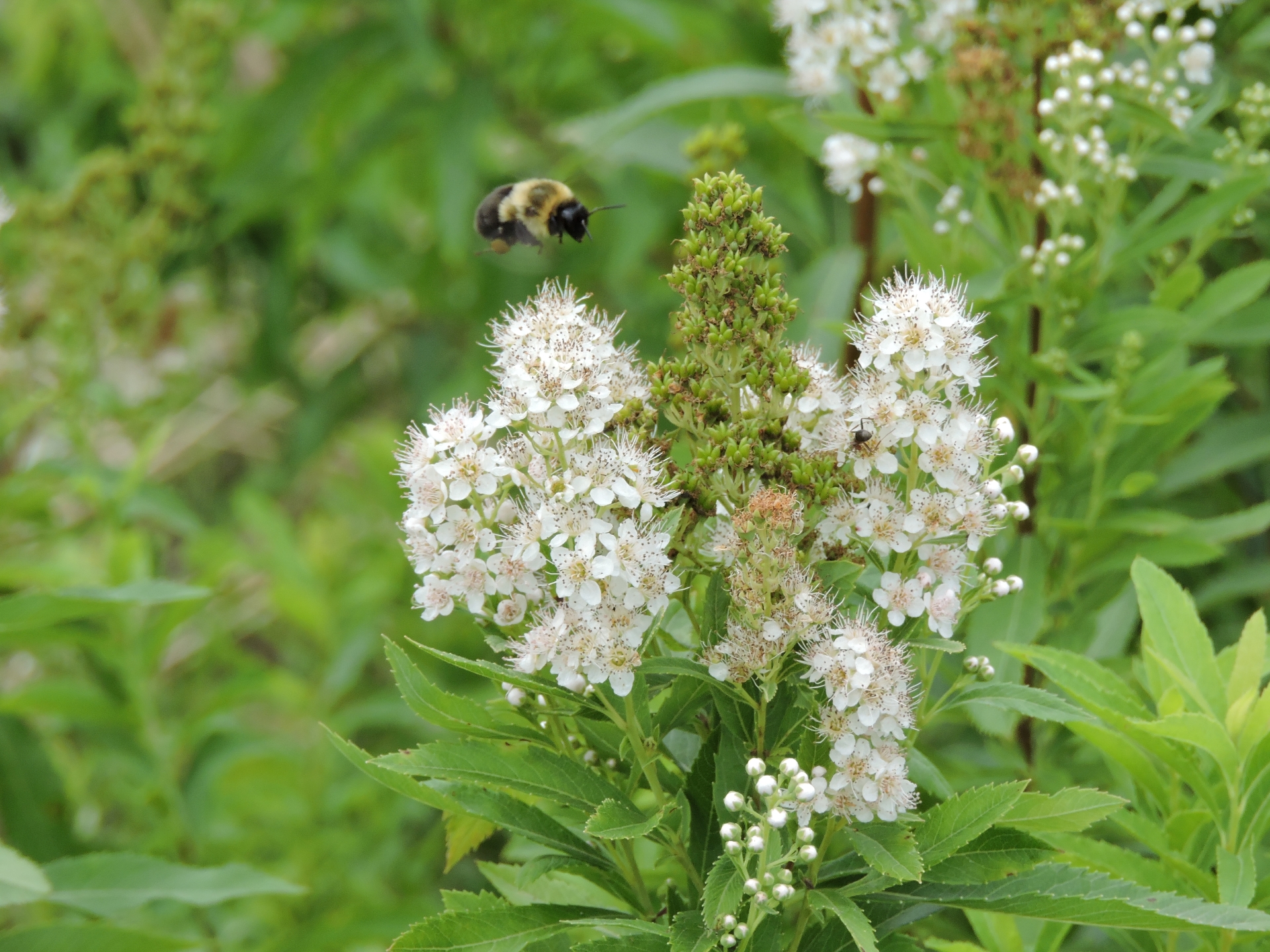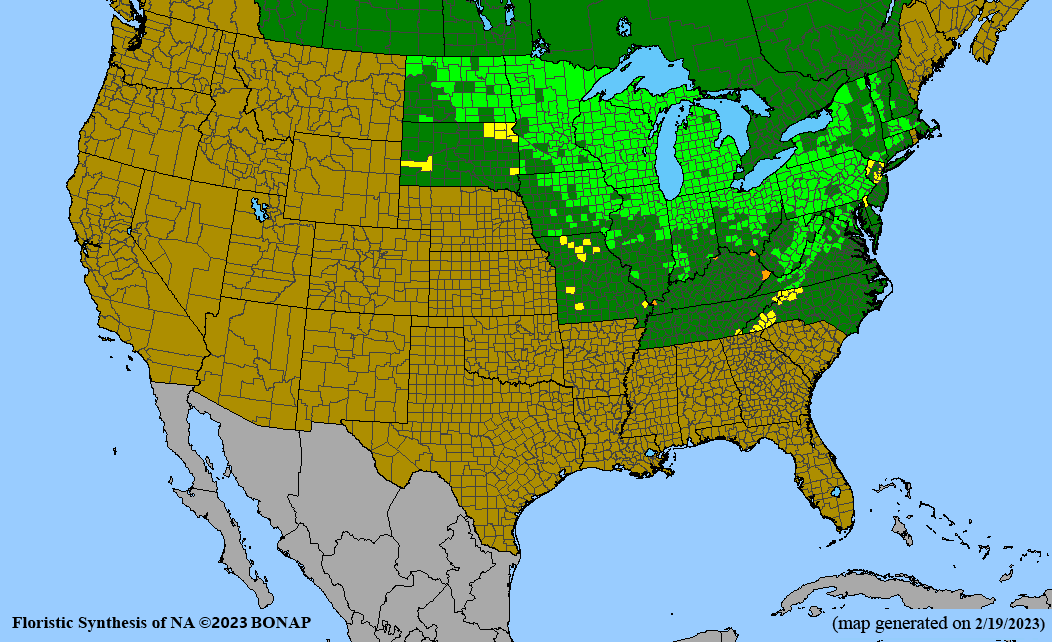white meadowsweet
Table of Contents

Spiraea alba Du Roi
Alternate Common Names: meadow sweet, meadowsweet, narrow-leaved meadowsweet, American meadowsweet, pale bridewort, pipestem, queen of the meadows
Family: rose family (Rosaceae)
Functional Group: woody species, shrubs
Description
- Life cycle and growth form
Perennial shrub with woody root system, growing in colonies of slender stems.
Height: 2-4 ft

- Leaves and stem

Leaves are alternate, mostly hairless, narrowly elliptic, 2-3 in long and 3/4 in wide, with finely serrate margins and short petioles; stems are smooth, slender, and woody, with few branches, becoming brown with age, multiple stems produced from the same rootstock.
- Flower, fruit and seedhead
Flower: Radially symmetrical, 1/4 in wide flowers are five-parted with white petals, a pink, yellow, or orange center ring, and long stamens that stick out from the flowers; inflorescence is a branched cluster of spikes 2 - 6 in long, each with numerous flowers, blooming from the top down.
Fruit/seedhead: Each flower forms four to six (usually five) dry, reddish-brown fruits (follicles), arrayed in a star-like cluster; each follicle is tough, short-beaked, hairless, and contains 2-5 seeds; ripe follicles split open along one side to release the seeds.
Pollination: insects, particularly bees

- Seed
Seed characteristics
Seeds per ounce: 300,000 (Prairie Moon)
1000 seed weight: 0.88 g (Seed Information Database)
Description: Slender, banana-shaped seeds are 2 mm long by less than 0.5 mm wide and a rusty orange color.
Typical seed test
TZ-PLS: 53%
Purity: 60%
TZ: 88%
(averages obtained from 3 seed lots produced at TPC)
- Habitat and range
Habitat: Grows in moist to wet soil in full sun; found in wet prairies, along streams, bogs, marsh edges, ditches; Facultative Wetland status in Midwest (USDA Plants Database); benefits from irrigation in seed production systems.
Conservation status: Global- G5, secure; Delaware and Tennessee- S1, critically imperiled; North Carolina- S2, imperiled; South Dakota- S3, vulnerable (NatureServe)

General Comments
The long flowering time and abundance of nectar and pollen make this an important food plant for many kinds of bees as well as small butterflies, wasps, beetles, and flies. We have observed the endangered Rusty Patched Bumble Bee visiting the flowers in white meadowsweet seed production plots. The dense colonies of stems provide shelter and nesting habitat for some bird species. The leaves, stems, and/or roots have uses in the traditional medicine and foodways of several Indigenous groups within the plant’s native range. Recommended for use as a low hedge, in perennial borders, wet prairie restorations, and roadside plantings.
Recommendations for Seed Production
- Establishment for seed production
Direct seeding
We do not have experience with direct seeding this species for seed production.
Greenhouse
Seed pre-treatment: 45 days cold-moist stratification.
Sowing: Seeds are small and must be surface-sown; stratified seed germinates quickly (starting 5 days from sowing).
Transplanting: Seedling plugs (2.5 in deep, 73-cell trays) are ready to transplant about 12 weeks from germination. After several weeks in plugs, seedlings benefit from fertilizer application such as a sprinkling of coated fertilizer pellets. Harden off outside, then dibble into a weed barrier in irrigated production rows.
- Stand management
Weeds: Few issues if weed barrier used in planting year; dense foliage shades out most weeds in subsequent years; mow and trim between rows.
Pests: A few stems are affected by dark colored aphids that cause distortion of leaves and growing shoot tips.
Diseases: None noted.
Note: Mow plots down to 4 in during the dormant season every other year to stimulate production of robust new stems.
- Seed production
 First harvest: second year
First harvest: second yearYield: 25-90 pounds/acre (based on 2 plots)
Stand life: at least 8 years
Flowering date: June - August
Seed maturity/Harvest date: late October - early November
Seed retention: Shattering of seed from open capsules begins in late October to early November.
Harvest date range at TPC (2017-2023): Oct 17 - Nov 1
Recommended harvest method: Check plots frequently from mid-October through early November; hand clip or combine when follicles (dry fruits) have split open on most stalks.
- Seed cleaning and storage
Cleaning process: Do NOT use a brush machine. Brushing pulverizes the dried leaves, making it very difficult to extract the fine seed. Hand-clipped material can be beaten in a cloth bag to release seed. Combined or hand collected material can then be treated in the same way: run through 1/4 in hardware cloth to remove sticks, then airscreen. If greater purity is desired, passing the cleaned seed through soil sieves can remove residual chopped leaf material.
Seed storage: cool/dry (33-50° F, 30-50% RH)
Released Germplasm
Source Identified material: Natural Selections/Iowa Ecotype Zones 1 and 2
- References
Chayka, K. (n.d.). Spiraea alba (white meadowsweet). Minnesota Wildflowers. https://www.minnesotawildflowers.info/flower/white-meadowsweet
Cochrane, T. S., Elliot, K., & Lipke, C. S. (2014). White meadowsweet. In Prairie plants of the University of Wisconsin-Madison Arboretum (3rd ed., p. 314). University of Wisconsin-Madison Arboretum.
Hilty, J. (2019). Meadowsweet - Spiraea alba. Illinois Wildflowers. https://www.illinoiswildflowers.info/wetland/plants/meadowsweet.htm
Kartesz, J.T., The Biota of North America Program (BONAP). 2023. North American Plant Atlas. (http://bonap.net/napa). Chapel Hill, N.C. [maps generated from Kartesz, J.T. 2023. Floristic Synthesis of North America, Version 1.0. Biota of North America Program (BONAP). (in press)]
NatureServe. 2024. NatureServe Network Biodiversity Location Data accessed through NatureServe Explorer [web application]. NatureServe, Arlington, Virginia. Available https://explorer.natureserve.org/. (Accessed: February 28, 2024).
Michigan State University Extension (n.d.) Meadowsweet. MSU Extension Native Plants and Ecosystem Services. https://www.canr.msu.edu/nativeplants/plant_facts/meadowsweet
Runkel, S. T., & Roosa, D. M. (2009). Meadow sweet. In Wildflowers of the tallgrass prairie: The upper Midwest (2nd ed., pp. 142–143). University of Iowa Press.
USDA NRCS National Plant Data Team. (n.d.). Spiraea alba Du Roi. USDA plants database. https://plants.usda.gov/plant-profile/SPAL2
Species Guide Updated 12/18/2024



